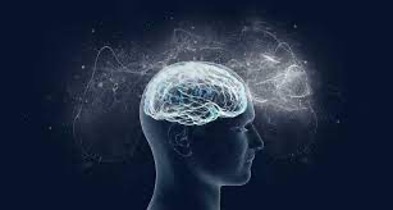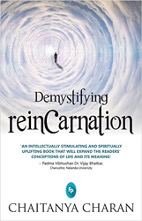- Visitor:29
- Published on:
Materialist Theories about Consciousness.Exploratory Studies in Reincarnation.
What is consciousness? The phenomenon of consciousness eludes precise scientific definition. This excerpt from the book ‘demystifying Reincarnation’ by Shri Chaitanya Charan Das offers scientific and rational counters to materialist theories about consciousness.

In the previous excerpt from the book ‘Demystifying reincarnation’, the author Shri Chaitanya Charan Das Ji explored aspects of the phenomenon of consciousness by raising questions about its nature followed by some intuitive reflections on these questions. In this excerpt, the author discusses the materialist theories about consciousness and offers rational and scientific counters to these theories. Read on to learn more.
Problems with Materialist Theories about Consciousness
Science’s biggest mystery is the nature of consciousness. It is not that we possess bad or imperfect theories of human awareness; we simply have no such theories at all. About all we know about consciousness is that it has something to do with the head, rather than the foot
– Physicist Nick Herbert, Quantum Reality: Beyond the new physics.
Today, many scientists approach the universe in strictly materialist terms; that is, they consider matter the only reality. These scientists generally see the universe, in all its variety and complexity, as merely the interplay of atomic particles functioning according to natural laws. Unsurprisingly therefore, many neuroscientists believe that consciousness emerges from the electrochemical activity of the nerve cells in the brain. But materialist explanations of consciousness have been challenged by several eminent neuroscientists. Noble Laureate neuroscientists such as John Eccles, Wilder Penfield, and Charles Sherrington hold that a complete explanation of consciousness requires at least some consideration of non-material aspects.
This openness to exploring nonmaterial explanations echoes the conclusion of another Nobel Laureate psychologist Albert Szent-Gyorgyi, given in biology today: “in my search for life, I ended up with atoms and electrons, which have no life at all, and somewhere along the line, life has run out through my fingers. So, in my old age, I am now retracing my steps.”
Why are so many eminent scientists considering a serious reassessment of the materialist approach to explaining consciousness? Well, when examining the idea that the brain is solely responsible for producing the phenomenon we call consciousness, at least three fundamental questions remain unanswered:
- How can brain cells, which are themselves unconscious dead matter, produce consciousness?
- How do our memories stay intact despite the constant regeneration of our brain cells?
- How can consciousness change the structure of the brain as observed in neuroplasticity?
- How Can Unconscious Brain Cells Produce Consciousness?
This problem has perplexed modern science right from the seventeenth century when the materialist approach first started gaining prominence.
In the nineteenth century, consciousness still remained a problem, as noted by the English biologist T.H Huxley in his book The Elements of Physiology and Hygiene: “How is it that anything so remarkable as a state of consciousness comes about as a result of irritating nervous tissue, is just as unaccountable as the appearance of the Djin when Aladdin rubbed his lamp.”
And even now, in the twenty-first century nearly four hundred years since scientists started struggling with this problem no explanation has been found, as admitted in the special 125th anniversary issue of Science published in 2005. That issue of this reputation publication off the American Association for the Advancement of Science featured 125 questions that scientists were at that time unable to answer. The second most important unanswered question, after the question “What is the Universe made of?”, was ,“What is the biological basis of consciousness?” In that special issue, science writer Greg Miller framed the problem in this way: “How [can] a particular pattern of photons hitting the retina produce the EXPERIENCE of seeing say, a rose.”
Why is the simple act of seeing a rose such a difficult thing to explain? When we see a rose, light rays of various frequencies enter the retina of our eyes. The eye cells react to the amount of light entering and then generate electrochemical impulses that pass through the optic nerve to the visual areas of the brain. This activates certain nerve cells and their connections with other cells.
What happens next? How does the image of a rose emerge in our consciousness? Where does the experience of seeing and feeling take place? Who is it that sees the rose? And who is it that feels the unique emotions associated with such an experience?
When confronted with search perplexing questions, some scientists claim that somehow or the other brain cell activity alone gives rise to the experience of seeing, the sense off “I- ness,” and, in general, the whole phenomenon of consciousness.
But other scientific researchers have pointed out that the activities of the brain cells and our conscious experience of emotions are two very distinct things. This is explained by astrophysicist Piet Hut and philosophy professor Bas Van Fraassen, both from Princeton University, in the Journal of Consciousness Studies: “If I’ve ever seen an incompatible pair of concepts, it’s a configuration of molecules and a conscious experience! Life ‘emerging’ out of lots of molecules; consciousness ‘emerging’ out of lots of nerve cells. Well, why not consider time as ‘emerging’ out of clocks? Without clocks, no accurate time measurements. And a good clock provides excellent correlations with the flow of time. but time surely does not ‘emerge’ out of a clock.”
Colin McGinn, a philosophy professor from the University of Miami, highlights the problem in reducing the ineffable complexity of the conscious experience to simple brain activity: “The brain processes held to constitute conscious experience consist of physical events that can exist in the absence of consciousness. Electricity in the brain corelates with mental activity, but electricity in your TV presumably does not- so how can electrical process be the essence of conscious experience?” (New Statesman magazine, 20 Feb 2012)
The fundamental feature of consciousness that differentiates it from brain cell activity and so stalls all materialist explanations is stated emphatically by neuroscientist Steven Harnad in the Journal of Consciousness Studies(Volume 7, number 4, April 2000), “The problem is clear, hard, and staring us informally in the face: I HAVE FEELINGS.” This is technically called as the hard problem of consciousness.
Thus a detailed study of the brain offers no adequate explanation on how it could possibly produce consciousness. Still, that’s not the only problem with a purely materialistic approach.
- How Do Our Memories Stay Intact Despite the Constant Regeneration of Our Brain Cells?
It had long been believed that once we reach our adulthood, we can never grow new brain cells. However, cutting- edge research has forced re- evaluation of this belief. A team of scientists from Harvard University, the Salk Institute, and the Sahlgrenska University Hospital in Sweden reported in the journal Nature Medicine, “…Cell genesis occurs in human brains, and… the human brain retains the potential for self- renewal throughout… life.”
In a New York Times article neuroscientist Dr. Elizabeth Gould Off Princeton University, who was one of The Pioneers of this discovery, explained the serious questions it raised: “People believed that in order to store memories for a lifetime, you need a stable brain. If cells are constantly dying and new ones are being produced, how would that be possible?”
Imagine that you wrote a message on a piece of paper and then you were able to one by one, gradually replace the molecules that make up that piece of paper. Suppose you completely replaced all the molecules and found that the new papers still had the same message written on it. Wouldn’t that be incredible?
Of course, this is a simple example for illustrating the extremely complex and largely unknown mechanism that links memories and brain cells. But it’s simply notwithstanding, it highlights the problem that confronts any mechanism as consciousness researcher Dean Radin points out in his book Conscious Universe: “All of the material used to express that pattern [of information] has disappeared, and yet the pattern still exists. What holds the pattern, if not matter? This question is not easily answered by the assumptions of a mechanistic, purely materialistic science.”
This question is actually so difficult to answer that it was also mentioned in Science’s list of the key 125 unanswered questions. And the answer remains elusive despite enormous strides in brain research during recent years. Perhaps a more productive approach might be to re-consider the materialist assumptions that make the problem so difficult to solve.
Is it possible that our memories are stored not just in the brain but also somewhere else, possibly in a place somehow independent of the material body from where they are made available to the new brain cells? Of course, it’s true that damage to the brain usually impairs the functioning of the body. Damage to the speech centre of the brain, for example, often results in an inability to speak. But do such instances prove that the brain is the source of consciousness? Not necessarily. They demonstrate that the brain and consciousness are intimately connected but don’t specify the nature of that connection.
Renowned psychologist William James postulated that the correspondence between the brain damage and impaired bodily function could still be explained if we assume that the brain is merely transmitting, not producing consciousness. To illustrate this, he gave the example of the way a prism transmits light. When a prism is damaged, the light passing through it may be distorted.
Similarly, when the brain is damaged, consciousness passing through it may be impeded. A more contemporary example can be the relationship between a computer and its user. If the processor, the part of the computer responsible for running programs, somehow gets damaged, then the user won’t be able to perform basic functions, and his or her ability to run programs, analyse data, and so on would be impeded. If the brain were akin to a processor for consciousness, then damage to a particular brain area would prevent the conscious self from performing the bodily functions associated with that area.
This idea of consciousness being in at least some ways independent of the brain finds support in one astonishing discovery : some people are able to perform normal conscious activity despite having little or no brain.
“Is your brain really necessary?” That was the proactive title of an article published in December 1980 issue of Science. The article reported the surprising findings of neurologist John lorber off the University of Sheffield a former member of the Nobel Prize Committee.
Lorber had earlier return in a scholarly journal Development Medicine and Child Neurology (December, 1970) about two children suffering from acute hydranencephaly, a congenital disorder in which cerebrospinal fluid is present not around the brain but instead of the brain. Normally, children with this disorder don’t live for more than a year and even then, with brain functions severely impaired. But these two children, despite having no cerebral cortex whatsoever, were in all other respects normal.
In subsequent studies, Lorber found multiple cases in which people with less than 5% brain matter had IQs greater than 100, well within the average. The most dramatic case Lorber encounter involved a young student from the University of Sheffield itself: “there’s a young student at this university who has an IQ of 126, has gained a first- class honours degree in mathematics, and is socially completely normal. And yet the boy has virtually no brain. When we did a brain scan, we saw that instead of the normal 4.5- centimetre thickness of brain tissue between the ventricles and the cortical surface, there was just a thin layer of mantle measuring a millimeter or so. His cranium is filled mainly with cerebrospinal liquid.”
Lorber is not alone in reporting such findings. French physicist Gustave Geley for example, reported similar cases in his book From Unconscious to Conscious. From the early part of the 20th century, several anomalous cases have been documented of people who, despite having brains so severely damaged has to be practically inoperative, functioned quite normally.

And today, an extremely rare form of brain surgery seems to support Lorber’s findings. Charles Choi reports in the Scientific American (24 May 2007), “The operation known as hemispherectomy- where half the brain is removed- sounds too radical to ever consider, much less perform. In the last century, however, surgeons have performed it hundreds of times for disorders uncontrollable in any other way. Unbelievably the surgery has no apparent effect on personality or memory.” If the brain is the source of consciousness, how could removing half the brain have no effect on things as fundamental as memory or personality?
For many years, surgeons have been removing small diseased parts of the brain without significantly affecting patients’ memory. This is sometimes attributed to redundancy in the storage capacity of the brain; that is, the same memories may be stored in more than one place. So, the theory goes, even if part of the brain is lost, memories can be retrieved from elsewhere. Though this sounds plausible, the idea that as much as 50% of the brain is redundant- as hemispherectomy implies- is more difficult to believe. And some of Lorber’s subjects had normal memories despite having less than 5% of the brain matter typically off an adult human brain. To account for this, neuroscientists would have to claim that 95% of the brain is redundant, a claim that is nearly unreasonable.
Cases like these support the possibility that consciousness may originate from beyond the brain.
Yet another finding challenges the claim that consciousness is a mere product of the brain: thoughts have been found capable of changing the structure of the brain itself.
- How does consciousness alter brain cells?
A number of scientific studies have demonstrated that normal mental processes can cause changes in the structure of the brain. This phenomenon is called neuroplasticity and its discovery stunned the mainstream scientific world. Why? Because, up to that point, most scientists had generally assumed that consciousness was a byproduct of the functioning of the brain. As a byproduct it should have had no capacity to affect the brain, its source. At that point in time, the power of thought to impact one’s sense of well- being and one’s general health had been well- known, but the power of thought to change the physical structure of the brain had hardly even being considered.
Psychiatrist Norman Doidge, in his New York Times bestseller The Brain That Changes Itself gives inspiring accounts of many patients who cured severe brain disorders by changing their thought habits, even though their disorders had been deemed incurable by conventional means. Changes in their thought patterns actually led to the formation of new connections in their brain cells, which in turn restored them to normal health.
Neuroplasticity is also documented in the book The Spiritual Brain by neuroscientist Mario Beauregard and science journalist Denys O’ Leary. They report that many studies have shown how trust and positive expectations can bring about an actual biological change in the brain.
Norman Doidge explains that these findings are “the most important alteration in our view of the brain since we first sketched out its basic anatomy and the working of its basic component, the neuron. Like all revolutions, this one will have profound effects.”
One profound effect, of course, is the re- evaluation of the claim that consciousness is a mere by product of brain function. As Pim Van Lommel Observes, “It would be incorrect to claim that consciousness can only be a product of brain function. How can a product have the ability to change its own producer?”
If consciousness is not produced by the brain, then it stands to reason that it could have an existence independent of the brain. This idea is substantiated by the experiments of Nobel Laureate Dr. Wilder Penfield, documented in his book The Mystery of the Mind.
Penfield conducted several experiments designed to investigate the relationship between simple physical activities, such as raising or lowering one’s arm, and the corresponding activities that happened in the brain.
At first Penfield observed that when a subject was told to raise his or her arm, a specific part of the cerebral cortex was activated. And when the subject was told to lower the arm, the part of the brain was deactivated.
Next, Penfield observed that when he used electrodes to artificially activate that specific part of the brain, the subjects’ arm rose automatically. When Penfield asked the subjects, “Did you raise your arm?” The reply came, with conviction: “I didn’t raise my arm; you raised it.” When Penfield deactivated that part of the brain, the arm went down. Again, the subjects were sure that that this had happened without their personally doing anything about it.
Exactly what are the implications of this simple experiment? In both cases, activating and deactivating the brain led to the raising or lowering of the subjects’ arm. But who or what was responsible for activating and deactivating the brain?
In the second part of the experiment, it was Penfield an external agent, who physically stimulated the brain and caused the subjects’ arm to react correspondingly. But in the first part, who was the agent responsible for stimulating the brain when the subject raised his arm voluntarily?
Penfield conducted several other experiments that demonstrated that no stimulation could ever make the subjects feel they were the ones responsible for raising their hands, regardless of which part of their brain was stimulated. To put it another way, wherever he looked in the brain, Penfield could not find the person the individual conscious presence responsible for telling both the brain and the arm to act.
After more than four decades of research, Penfield concluded in The Mystery of the Mind, “The brain is a computer… But it is programmed by something that is outside itself.”
Echoing this point Pim Van Lommel in his book Consciousness Beyond Life quotes another Nobel Laureate, Sir John Eccles, “The brain is the messenger to consciousness.”
To conclude, the claim that the brain alone produces consciousness is theoretically and empirically open to question because:
- Our memories are unaffected by the regeneration of the brain cells.
- Some people can function normally despite having a fraction of the total brain matter they are expected to possess.
- Thoughts have the power to change the structure of the brain.
- The individual conscious entity responsible for making the decisions that cause the body to move cannot be found anywhere in the brain.
All these points strongly suggest that consciousness has its own existence distinct from the brain, and that consciousness is not a product of the brain, but is its user. The brain is the tool for consciousness. If consciousness does indeed exist separately from the brain, then it could also exist separately from the body, as near- death experiences and past- life memories suggest.
- 14 min read
- 0
- 0










